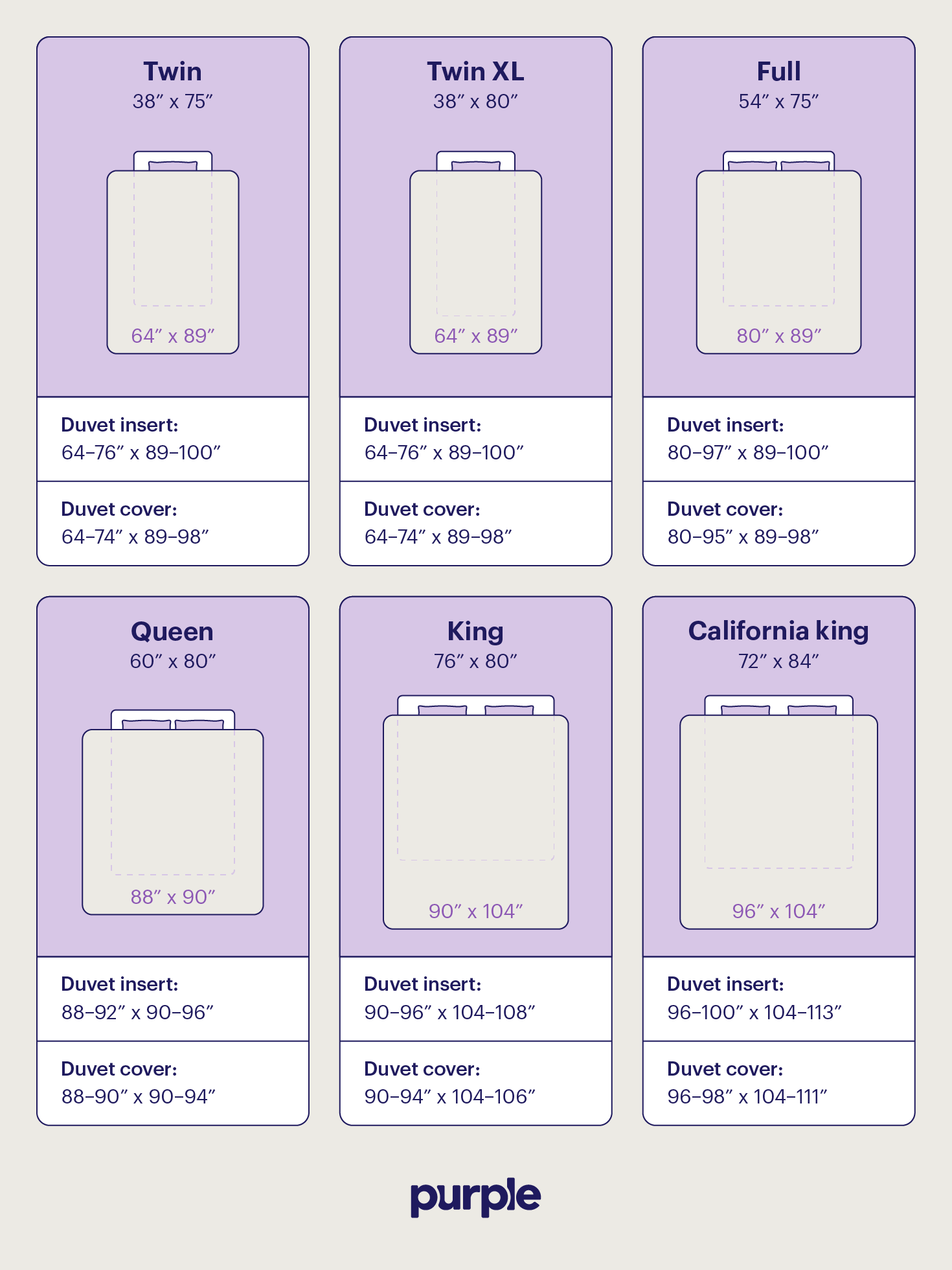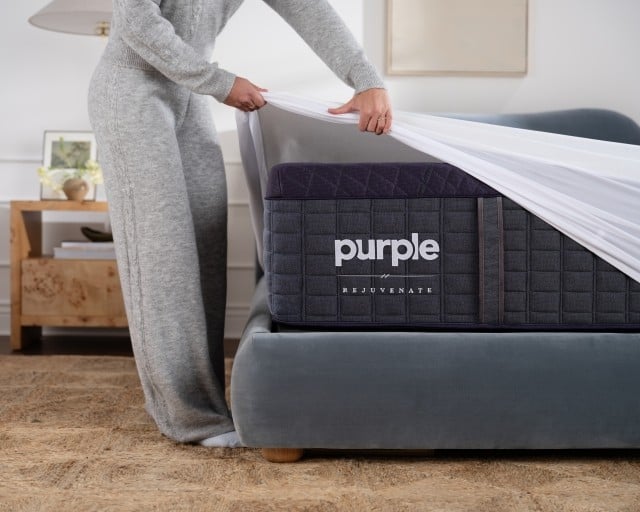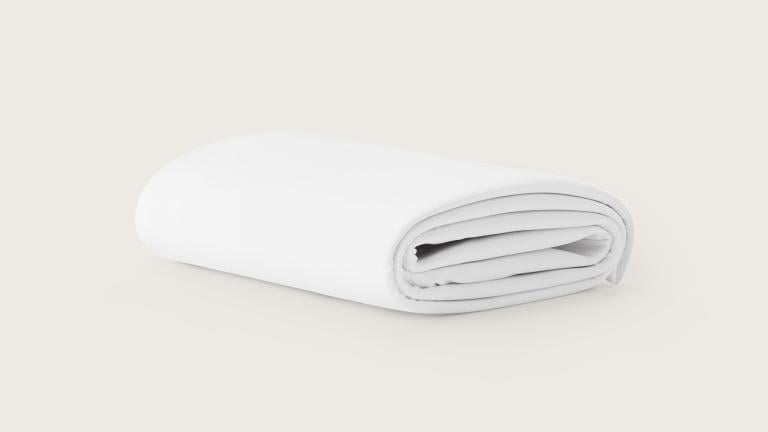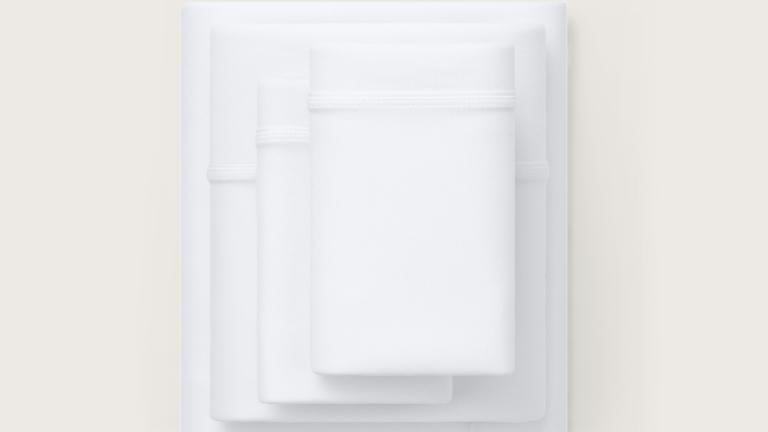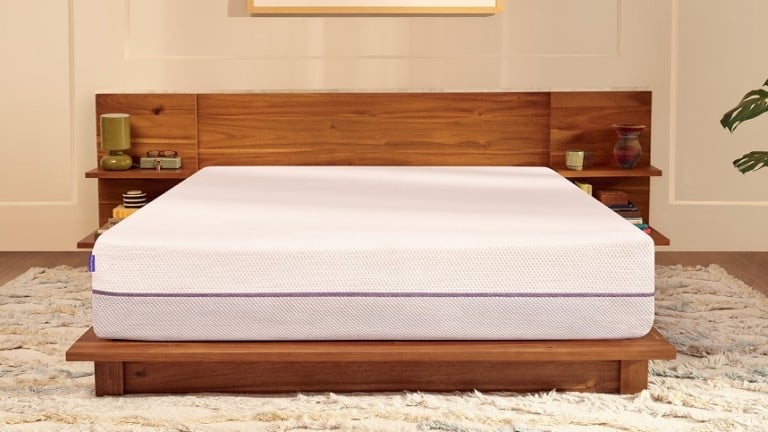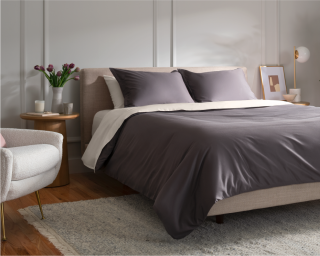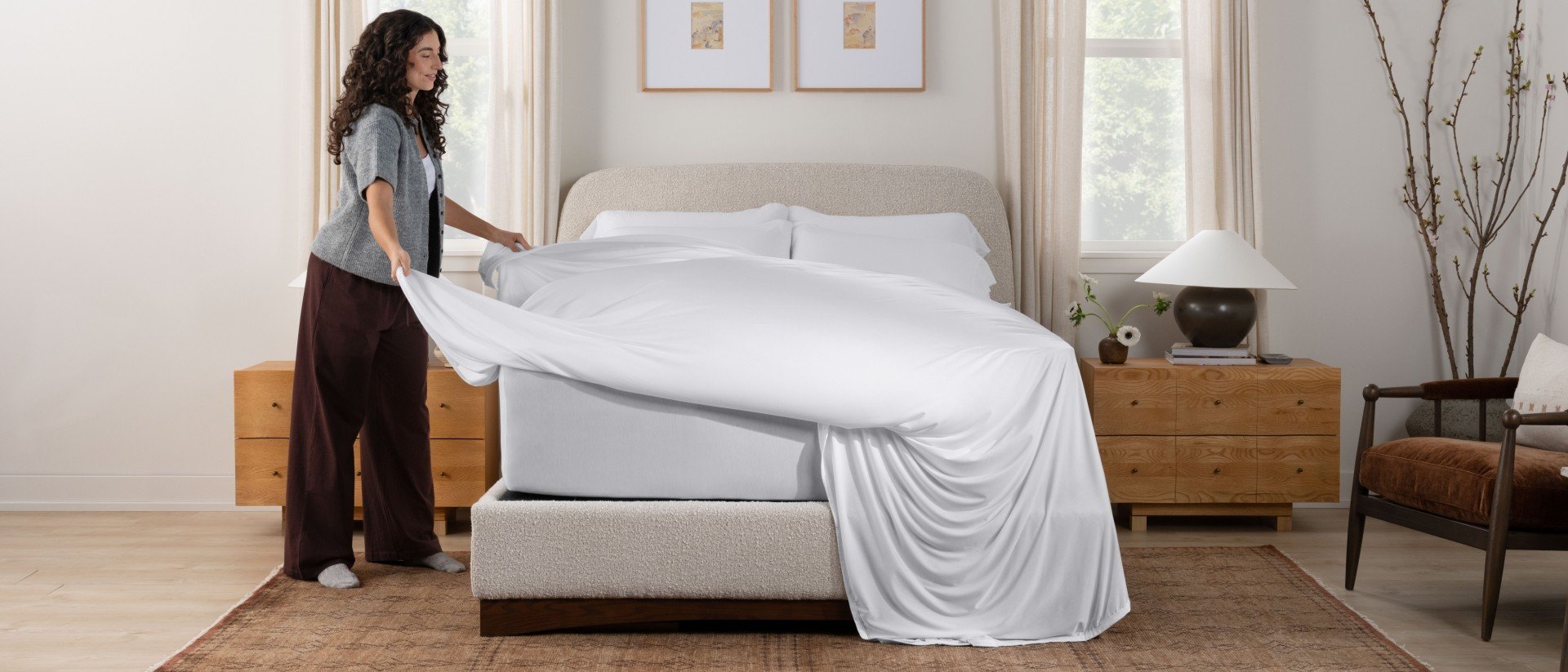
Duvet Sizes Guide: Dimensions + Size Chart
What Are Standard Duvet Sizes?
In the U.S., the standard duvet sizes are the same as standard mattress sizes, though measurements can vary by manufacturer. Size ranges include:
- Twin/twin XL: 64-74” x 89-98”
- Full: 80-95” x 89-98”
- Queen: 88-90” x 90-94”
- King: 96-98” x 104-111”
- California king: 90-94” x 104-106”
The right bedding can make a major difference in your nightly comfort. Even if you’ve got your flat and top sheet situation figured out, your bed may not look complete without another layer.
Whether you need the extra warmth or you just want an elegant draped look, choosing the right duvet size can make all the difference.
That’s why we made this simple buyer’s guide to duvet sizes. By the end, finding the perfect covering for your bed will be more accessible than ever.
Duvet Size Chart
Unlike standard sheet and bedding sizes, different duvet sizes can be paired with several sizes of mattress. Manufacturers tend to produce these covers with a bit of leeway in mind, so there’s always a little bit of extra material if you want to upgrade your bed.
Here are a few common duvet cover sizes and their compatible mattress dimensions. Keep in mind that sizes may vary by manufacturer, so you can find options that are longer or wider if you prefer a draped look or have a thicker mattress.
Mattress size | Dimensions (in) | Dimensions (cm) |
Twin | 64-74 x 89-98 | 162-188 x 226-249 |
Twin XL | 64-74 x 89-98 | 162-188 x 226-249 |
Full | 80-95 x 89-98 | 203-241 x 226-249 |
Queen | 80-95 x 89-98 | 224-229 x 229-239 |
King | 96-98 x 104-111 | 229-239 x 264-269 |
California king | 90-94 x 104-106 | 244-249 x 264-282 |
When you’re buying a duvet, remember that the dimensions of the cover and insert may be slightly different. Often, duvet inserts can be up to 2 inches wider and longer than the covers to ensure a fluffier feel.
Twin and Twin XL Size Duvet
Width (in) | Length (in) | Width (cm) | Length (cm) | |
Duvet insert | 64-76 | 89-100 | 162-193 | 226-254 |
Duvet cover | 64-74 | 89-98 | 162-188 | 226-249 |
Twin and twin XL beds are a staple for guest rooms, kids’ rooms, and smaller studio apartments. Since twin XL beds are especially popular for teens and college students, you usually won’t have trouble finding sheets and other bedding in this size — especially since duvets and comforters are typically large enough to fit both twins and twin XLs.
Full Size Duvet
Width (in) | Length (in) | Width (cm) | Length (cm) | |
Duvet insert | 80-97 | 89-100 | 203-246 | 226-254 |
Duvet cover | 80-95 | 89-98 | 203-241 | 226-249 |
Double beds are slightly wider than twin beds, making them an excellent pick for active single sleepers. Comforters and duvets are often versatile, and while you can purchase separate full and queen size duvets, you may also find options in a full/queen size that account for both sizes.
The double/queen duvet can result in a tight-feeling squeeze if you and your partner tend to tug on the sheets or if you have a particularly thick mattress and want your top layer to drape down over the sides. That said, this may not be a problem if you sleep alone or are a relaxed sleeper.
Queen Size Duvet
Width (in) | Length (in) | Width (cm) | Length (cm) | |
Duvet insert | 88-92 | 90-96 | 224-234 | 229-244 |
Duvet cover | 88-90 | 90-94 | 224-229 | 229-239 |
Compared to the full size, queen beds are heftier and better suited for couples who like to sleep together. A true queen size duvet will drape over the edges of your mattress, providing ample coverage.
You can use a full/queen size if you aren’t picky about the appearance of your bed, or opt for a king size duvet for an indulgent look, but the best fit will be a queen size cover.
King Size Duvet
Width (in) | Length (in) | Width (cm) | Length (cm) | |
Duvet insert | 90-96 | 104-108 | 229-244 | 264-274 |
Duvet cover | 90-94 | 104-106 | 229-239 | 264-269 |
King and California king beds are the two largest standard options on the market, where the standard king is wider and the Cal king is longer.
Even though the difference in dimensions is fairly small, buying the correct bedding size ensures a snug and comfortable fit. While you can purchase a king/California king duvet, the combined size may not be ideal for everyone. For couples, your sleep positions and habits could mean a larger duvet is better to avoid leaving anyone in the cold.
California King Size Duvet
Width (in) | Length (in) | Width (cm) | Length (cm) | |
Duvet insert | 96-100 | 104-113 | 244-254 | 264-287 |
Duvet cover | 96-98 | 104-111 | 244-249 | 264-282 |
Narrower and longer than a standard king, a California king bed requires special bedding in most cases. Some duvets can comfortably cover both sizes, but opting for a California king duvet size will ensure you have the length necessary to cover the foot of your bed.
Differences in Duvet Sizes Between Regions
Depending on where you’re shopping for a duvet, you may find that the sizes vary more than a few inches.
European (EU) and United Kingdom (U.K.) duvet sizes are distinct from U.S. sizing, and while you’re unlikely to find options listed in U.K. or EU sizes, it’s helpful to have a sense of different sizes to ensure you get the best fit.
U.K. Duvet Sizes
U.K. bed sizes are different from those in the U.S., even though a few options share a name. Whether you’re living in the U.K. or you purchased a bed from an international manufacturer, make sure you pair your bed with the right size bedding to maximize your comfort.
Size | Dimensions (cm) | Dimensions (in) |
Single | 135 x 200 | 53 x 79 |
Double | 200 x 200 | 79 x 79 |
King | 225 x 220 | 89 x 87 |
Super king | 260 x 220 | 102 x 87 |
While the U.K., EU, and U.S. have a super king bed size, they do not have the same dimensions. In the U.S., a super king bed is smaller than a standard king, but in the U.K. and EU, a super king is closer to what we know as a California king.
European Duvet Sizes
Compared to U.K. sizes, European Union beds are often slightly larger. In most cases, you should be able to use a U.K. duvet on an EU bed and vice versa, but as with all bedding, choosing the correct size is the best way to ensure a comfortable fit.
Size | Dimensions (cm) | Dimensions (in) |
Single | 140 x 200 | 55 x 79 |
Double | 200 x 200 | 79 x 79 |
King | 240 x 220 | 94 x 87 |
Grand king/super king | 260 x 240 | 102 x 94 |
Additional Considerations for Choosing a Duvet
Size isn’t the only thing you need to consider when purchasing a duvet for your room, and neglecting the other factors might result in a subpar sleeping situation. Here are three additional considerations you should make before you commit to a purchase.
Thread Count
The term “thread count” might sound like a convenient buzzword used to make a duvet sound fancy, but it’s a vital comfort metric. Duvets, like sheets, use thread count to determine how many threads are present in 1 square inch of material, with higher numbers often indicating softer and more breathable sheets.
Lower thread counts aren’t necessarily worse, with many options still providing a comfortable and breathable experience for less cash. That said, if you’re looking for the best bang for your buck, we recommend considering options with a thread count of over 200. Any less than this, and you may end up purchasing sheets that wear out more quickly.
Cover Material
Duvets typically consist of an “outer shell” or covering, a blanket, and the inner filling. While the outer covering can be swapped out for aesthetic and temperature reasons, it’s also essential to consider the included shell. After all, most people don’t purchase more than one duvet covering unless they’re very particular.
Here are a few common materials used for sheets and duvet coverings:
- Bamboo: Bamboo is a popular sustainable option that’s also soft, breathable, and very durable.
- Cotton: Cotton duvet coverings are some of the most flexible options on the market. Some are on the more affordable side, while others lean toward the luxury market.
- Silk: Silk is a luxurious and smooth material woven by silkworms. While beautiful, silk duvet covers can be expensive and difficult to clean once stained.
- Polyester: Polyester is the number one choice for budget-friendly buyers, but that doesn’t mean they’re low quality. We recommend checking out polyester covers in person before making any purchasing decisions.
Filling
Duvet blankets contain a filling layer that creates the soft sleeping experience people have come to love. Some duvets have more luxurious filling layers than others.
Here are a few of the most common types of fillings you’ll encounter when shopping for a duvet:
- Wool: Wool duvets tend to be quite warm, but many modern manufacturers have developed filling blends that promote airflow as you sleep. Like synthetic polyester fills, these are hypoallergenic.
- Feathers: Plucked from actual birds, feather fillings tend to be a bit bulkier than more fibrous options. Despite this, they tend to weigh less than common alternatives.
- Down: Down fillings are some of the softest and coziest options you can buy, but they can also be some of the most expensive options. If you have allergies and are considering a down vs. down alternative duvet, synthetic options are available.
- Synthetic polyester: Synthetic polyester is the artificial answer to down fillings, which means you get all the plushness without the potential allergic reactions. Moreover, these are machine-washable, making them an attractive option for many busy buyers.
Overhang
Before you choose a duvet size, you may want to consider overhang, or how much the duvet will hang over the edges of your bed. If you want to cover your entire mattress and bed frame, you will want a duvet that’s significantly wider and longer than the dimensions of your mattress. You can also use a duvet paired with a bed skirt or other bedding to achieve the same effect.
Get More Comfortable With Bedding From Purple
Duvets are like the cherry on top of the cake — they may not be a requirement, but they can improve the overall experience. Not all duvets are built with maximum comfort and value for money in mind, so it’s important to choose the right comforter or duvet size for your mattress.
If you’re in need of comfortable bedding, Purple has the perfect fit to maximize the benefits of your mattress so you can sleep soundly.
FAQ
Though similar, duvets and comforters differ primarily in how you should care for them. Comforters are a bedding accessory that is often designed as part of a set, while duvets have covers that can be swapped out when it’s time to clean up. Some people use duvet covers with their comforters to protect them from dirt and grime.
In most cases, yes, your duvet insert and duvet cover should be the same size, but some inserts are actually larger than the covers for a fuller look and feel. The dimensions shouldn’t vary too much if both pieces are the same size, as they typically vary by only an inch or two in width or length.
Duvets with synthetic fills are washable, while those with natural fillings like down and feather should be washed by hand. We recommend sending your duvet to a specialist cleaner if your natural fill bedding needs a thorough clean.
Yes, you need a duvet cover for your duvet. Using a duvet without a cover is like sleeping on a pillow without a pillowcase — you technically can, but you risk soiling your pillow or duvet. Because of a duvet's stuffing, washing and cleaning can be challenging, but using a cover will save you a lot of trouble.
More To Explore
Level up your sleep routine with our most-loved products.



